CHAPTER 4:
DIGITAL TECHNOLOGY
In a relatively short time, digital technology has changed the world of photography in an irrevocable way. In 2004, roughly half of my students at BetterPhoto.com shot digital capture and half shot film. Today, less than six years later, fewer than one in one hundred shoot film. Of the photographers I interviewed for this book in 2004, 30 percent still shot with film some or all of the time. Now none of us shoot film with any regularity. It's not just camera equipment that has changed with the advent of digital photography. The way we shoot images, edit them, present them to clients and store them are all new. Many elements of the photographic process have become easier and cheaper.
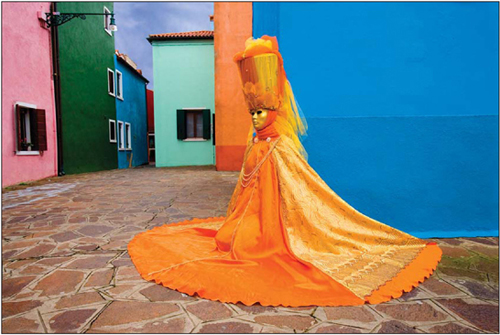
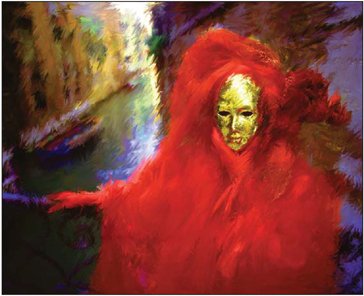
These images by Jim Zuckerman demonstrate the broad range of visual styles we can achieve using image editing software. On the left is a beautiful, classic visual treatment with minimal editing, and the one on the right has a creative treatment applied that gives it a very painterly affect.
The shift to digital photography created big, burning questions from professional shooters: Will this new medium make it easier for bad photographers to create good images? As digital cameras and equipment became cheaper, more advanced and readily available, professional photographers worried that more and more mediocre photographers would crowd the market. Now that digital technology has been around for a while and we are able to witness the consequences, what is the reality?
“It's made everybody better!” says Peter Aaron. “We've raised the bar. Now bad photographers can do good work, and good photographers can do great work. I used to feel somewhat apologetic about my work when I encountered insoluble issues. Now we can do the impossible with Photoshop. One can put a gray scale right into a picture to help create perfect color balance. Two images can be taken from slightly different perspectives to eliminate a streetlamp. We no longer require color corrective gels on lights because we can shoot each type of light at its proper color balance and then merge the images together. Now no problem is too big.”
Most of the change has ultimately been good for professional and amateur photographers, for the photography market in general and for the end users/clients. Let's look at how.
AFFORDABLE HIGH-QUALITY EQUIPMENT
Digital technology has made high-quality camera equipment affordable and easy to use. This gives the professional photographer better tools for her tool belt, and it allows the talented amateur easier access to quality equipment. In the days of analog (film) cameras (and even during the early days of the digital revolution), quality equipment was prohibitively expensive and often large and awkward to use (think medium format cameras, manual focus, and industrial tripods). Now DSLR cameras create equal or better quality images and are comparable in size and ease of use to 35mm SLR cameras.
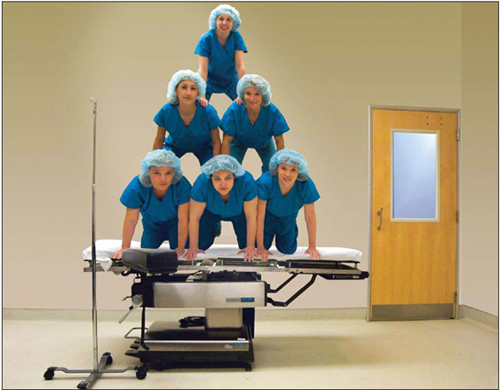
This image by Connie Cooper-Edwards, created to demonstrate teamwork in the workplace, is actually a composite of three images edited together in Photoshop.
VERSATILE CAPTURE OPTIONS
Digital technology allows the professional photographer many new freedoms simply not available with film capture.
Image cards are reusable and unwanted images can be deleted in-camera or on the computer in an editing program, thus eliminating the cost of film and the cost of processing and/or printing unnecessary images. This allows the shooting of more images without the cost mounting up.
Professional photographers now have the ability to change ISO at will: With digital capture the ISO is dictated by the camera body, whereas with film (analog) capture the ISO was determined by the roll of film itself. This way if you're shooting as the sun is going down and losing light quickly, you can go from a low to a high ISO just by setting a button rather then changing rolls of film.
Digital technology has improved resolution. Now there are some cameras that shoot at 3200 ISO or higher with amazingly little loss of detail and quality. This makes it possible to shoot successful images with ambient light in very low light situations.
Shooting in the RAW file format allows you to shoot now and then go back and change exposure up to two stops in either direction, as well as to change white balance and other aspects of the image without causing a loss of resolution.
FLEXIBLE PROCESSING OPTIONS
In the old analog days the professional photographer might have consulted with the guy at the lab about pushing or holding transparency film a half a stop. Even if she actually did her own processing it was by the batch — she couldn't process one image at a time. But with digital capture she can process one image at a time or batch process, as best fits her needs. And she can do it all in the light, with no toxic chemicals. She can enlarge the areas of the images she wants to see up to 200 percent and affect each area of tonal range and color individually rather than globally. She can make any number of originals so she can process and reprocess images and share originals to infinity and beyond!
ENHANCED RETOUCHING/IMAGE EDITING CAPABILITIES
In the days of analog film, if an image needed retouching, portrait photographers sent it to the lab and had their retoucher take care of it. The photographer could get blemishes removed, wrinkles softened and glasses glare eliminated. More work than that was unusual because the cost prohibited it. Commercial clients with bigger budgets could have their images airbrushed to make models seem prettier and products more appealing, but that was the exception.
Today, if a portrait photographer wants heads transplanted or subjects taken out of or added into an image he can do it himself using editing software — or farm it out. Either way, it's much more cost-effective. He can change backgrounds, eliminate clutter, bring families together who haven't been in the same room in years. In short, he can do the impossible and do it inexpensively.
GREATER PRESENTATION OPTIONS
All of the options can make it hard for the photographer to choose how to present preliminary work to his clients. Should he print hard copy proofs or make a projected slide show or show images in templates on the computer? Should he do only basic processing first and save the involved retouching for after the client has chosen her images? Should he include a press printed proof book with each order? When showing two or more images that will be edited together in the final product, how should he help the client visualize the end result short of doing the editing in advance? What if the client wants their images today — they want to walk out of your studio with all their images on a disk and they either don't want editing or want to do it themselves? These are all important questions, and ultimately all photographers must answer them for themselves based on the industry standards, their experience and their client demand.
For instance, a commercial photographer who shoots a 100-page hardware catalog has a client who probably wants all their images edited and ready to go in CMYK color space so all they have to do is send it along to their printer. An architecture magazine will want their editorial shots all edited and ready to print, as well. A wedding photographer may provide hard copy or digital proofs. These digital proofs could be available online for a limited amount of time so that the bridal couple's friends and family can order prints. Or he may hand over the e-files on disk or even on an external hard drive, edited or unedited, and allow his client to make prints at will.
GREATER CONTROL OVER THE FINAL PRODUCT
Whether our final product is a photographic print, a press print, a laser print, an electronic file or an art print, the photographer is now a partner in the outcome. she needs to be proficient in understanding color space (CMYK for press printing, sRGB for Web use, to name just two) file type, resolution and file size — the list goes on. She has more control and more responsibility. Her role has changed. To learn about or stay abreast of important image output techniques, I recommend registering for forums and communities at www.adobe.com. You can also subscribe to Photoshop User Magazine and/or Layers Magazine, two great periodicals.
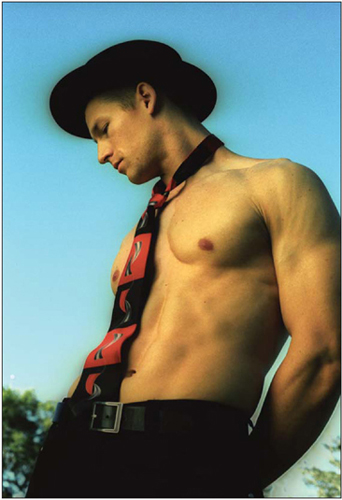
The high contrast, hand-colored looking portrait was created in Photoshop by Stephanie Adams.
MORE SOPHISTICATED ARCHIVING OPTIONS
In the old analog days we stored negatives in acid-free materials and kept them safe from fire and water. In our new digital world, we need sophisticated, reliable, redundant storage systems so that if one part of the system fails, the other part of the system preserves our work. These systems take up a lot less space and are easier to organize and sort than negatives. We explore archiving in depth in chapter ten.
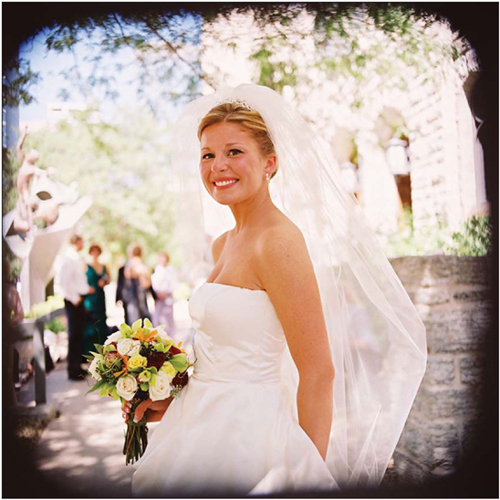
One of the beautiful effects made quick and easy with digital capture and editing is the image frame, like in this wedding photo by Hilary Bullock. Many are templates are available through professional printing labs, and they can also be purchased online from websites such as ittybittyactions.com, or you can create them yourself.
STREAMLINED WORK FLOW
Every step of the image-making, editing and preserving process falls into the category of “digital work flow.” Work flow and digital asset management are such large and unwieldy topics that there are books, seminars and software programs all designed to aid us in this aspect of our work. While our work flow has become infinitely more complicated with the use of digital technology, it ultimately allows us to create, present, output and store superior-quality images.
In a nutshell: the basic work flow requirements for the beginning professional photographer
1. CAPTURE. Capture is what you do with your camera. It's what we used to call “taking the pictures.” Anything that happens incamera is capture. In order to capture images, all you need are a camera, a lens and an image card (also called flash cards).
2. IMAGE BROWSER. After you capture your images, you will want to view, rate and keyword or otherwise categorize them (by date, subject, client, etc.). You do this by importing the images from the flash card to your computer via a card reader or a USB cord attached directly to the camera. There are many great browsers available, including Adobe Photoshop Lightroom and iPhoto. Many cameras come complete with their own browser software, and many editing programs come with browsers as well. For instance, Adobe Photoshop comes with the browser called Bridge, which is all I personally need for organizational purposes.

Digital editing allows photographers to incorporate text and borders into their images and to easily create image collages. These treatments are very popular with portrait clients. This example is by Vik Orenstein.
3. EDITING SOFTWARE. Examples of editing software are Adobe Photoshop, Picasa and Corel Painter. You can also purchase plug-ins that work with Photoshop and some other editing platforms to increase your capabilities. Some examples are Noise Ninja for noise reduction, Mystic Light and Color for artistic affects, and Blow Up from Alien Skin for enlarging files. Some clients want their image files unedited, but in this business environment you need to know how to do at least basic editing yourself or find a very trustworthy and affordable service to hire it out.
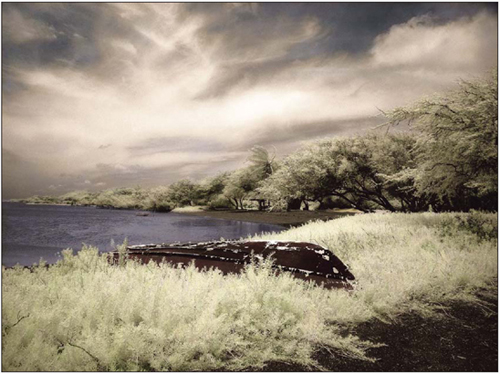
Fine art photographers have also benefited from the advances in photo editing software. This image was created by Kathleen Carr with a DSLR that was retrofitted to become an infrared camera, but similar treatments can be created with image editing software. The artist then colored the image.
4. REDUNDANT STORAGE SYSTEMS. With the freedom to create multiple originals comes the obligation to use them properly. You should always have at least two originals of each image stored on different computers or external hard drives. Ideally, these storage systems should be in different physical locations. For instance, I have one at home and one at my office. You should regularly back up active images and your computer and/or laptop desktops to your storage drive(s). Automated backup programs cost under $100 and are more reliable than human memory (at least my human memory).
5. OUTPUT METHODS. Eventually you will need to output your images. That means you will make photographic or off set prints, or burn CDs or DVDs to give to your clients. So you will need a lab, off set printer, CD/DVD reader/writer and/or some combination of these. E-files can also be sent electronically through online services such as YouSendIt.com.
THE EFFECT OF MORE PHOTOGRAPHERS IN THE MARKETPLACE
Yes, as feared there are more photographers competing in the marketplace. There aren't necessarily more top photographers. There are certainly more inexperienced and inexpensive photographers. As such, they are not really competing for the same pieces of the pie as the top dogs. For instance, a person who hires a wedding photographer off of Craig's List for $300 probably would never have hired a $3,500 shooter in any event. If anything, the $300 photographer saved the bride's Uncle Chuck from having to dust off his camera. And in the same token, a person who would hire the experienced $3,500 shooter wouldn't hire the $300 guy even in a bad economy.
There is something of a danger to the experienced pros who make their living in the photography biz from talented newcomers or amateurs who are willing to give their work away just to see their images in print. But this has always been the case and is not new to digital technology. So don't sell your work cheap — even if you're a newly minted professional. You'll only erode the marketplace for yourself and others, and the perceived value of your work will erode with it.
PITFALLS TO AVOID
All this digital stuff sounds like heaven, but every advantage that digital technology provides contains a hidden pitfall to avoid.
LAZY CAPTURE
The use of RAW capture is a great advantage when used carefully. But we can quickly turn into lazy photographers if we say to ourselves, “Gee, I can just shoot this now any old way and then fix it later in RAW!” While this is true to a degree, the best use of any image editing tool is to enhance an image, not to do damage control.
OVER RETOUCHING/IMAGE EDITING
It's important to remember that with every opportunity to improve an image with editing comes the possibility of going overboard and ruining it. For instance, digital technology allows portrait photographers to soften skin texture and sharpen eyes, two things that can contribute to the making of a great portrait. But overly softened skin tones and overly sharpened eyes can look artificial and even disturbing. Photographers have to take great care not to abuse these editing tools.
Architectural photographers can use Photoshop to populate an image with people. But again, one must not approach this type of editing carelessly. “There's no excuse for awkward poses or one-legged people,” says commercial photographer Peter Aaron, in reference to the fact that when one shoots a person walking at about 1/25th of a second shutter speed, often that person appears to have only one leg because one almost disappears in the motion blur.
Landscape photographers can edit their images to remove an excessively blue color-cast from an image. But as Jim Zuckerman points out, “What's wrong with a landscape with a blue cast to it? The sky is blue, the shadows have blue in them — should every image have a neutral cast? I don't think so.”
So how do we know when to stop? Richard Lynch, author of eight books on image editing including The Adobe Photoshop Layers Book, recommends making an outline of what you plan to do in your edit and then stick to it. If you decide to experiment as you go, write your intentions into the outline and put a limit on them.
INADEQUATE STORAGE/BACKUP
It's wonderful to have redundant storage capabilities. The only problem with them is that you have to use them or they don't work. Unfortunately, I'm speaking from experience. I have a lovely redundant storage system, but for a full two years I had floated along never having had any computer problems at all, so I got lazy and went a period of four months without doing any backup. Then the motherboard on one of my Macs failed and every image that was downloaded or edited on that computer was history. We were able to recover most of the files for a hefty $2,700 fee. Don't let it happen to you.
HAS ANYTHING STAYED THE SAME?
With all these changes, has anything stayed the same?
The answer is a resounding yes! After all, digital pixels, like film grain, are just different ways to record information. The essentials of good photographic technique haven't changed at all.
LIGHT
You still have to have great light, whether your image is a portrait, a product shot, a landscape or any other type of image. “Time of day is very important,” says Peter Aaron. No amount of editing will make an image look like it was shot at dusk if it was shot at high noon.
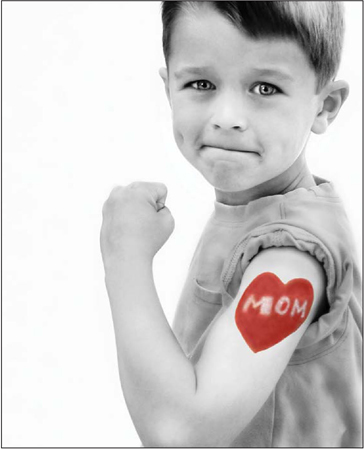
I originally tried to use face paint to create this “tattoo” for a Mother's Day portrait. The paint wasn't bright enough, but I went ahead and shot it, then enhanced the color using Photoshop.
FOCUS
You still need to have the appropriate areas of the image in focus. There is a certain amount of sharpening that can be done in Photoshop, but ironically images that are already sharp are the ones that benefit most from added sharpening.
CLARITY
We still want to create images with the highest resolution possible. With digital capture, we want the most megapixels, the largest sensor and the largest number of pixels per inch. Shooting at too high an ISO or at incorrect exposure can create low-resolution digital images, just as with film.
COMPOSITION
We still need to know how to place our subject in the frame and how to use background and foreground to create a pleasing composition. While digital technology allows us ease of cropping in the editing process, we still need to have good raw material to work with.
EXPOSURE
Yes, digital capture gives us more wiggle room than film capture when it comes to exposure. But again, any editing we do outside of RAW bruises pixels, so when it comes to exposure, it's always best to nail it.
While digital technology does not in any way lessen the importance of good technique, it does help make good technique easier to learn. Because we have instant feedback with digital capture, we can stand in the field and shoot the same scene with six different white balance settings or six different exposures and immediately see the results.
Digital technology has changed the photographic landscape forever, but it hasn't eliminated the need for great technique and creativity.
